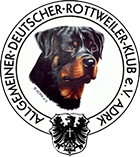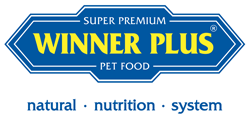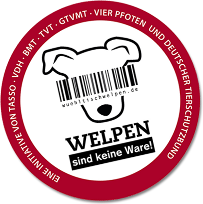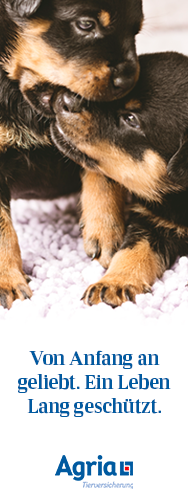| ADRK |
| Allgemeiner Deutscher Rottweiler-Klub e.V. |
How much food should my dog be fed?
Why is my dog suddenly getting fatter since I switched to a new type of food, even though I'm feeding him just as much as before? Why is there so much more in the bowl with wet food than with dry food? And why does my neighbor's dog get so much more food, even though her dog is hardly any bigger than mine? Many dog owners ask themselves questions like these about nutrition. You can read facts and interesting facts on the subject of food quantity in the following article.
Energy and nutritional requirements
The amount of food required daily depends on the individual dog's energy requirements. A dog's energy requirements in turn depend on several influencing factors. A dog's weight, size and age are initially the most important factors determining its requirements. However, other factors are often neglected, which must also be taken into account in order to ensure an optimal energy supply. These include, above all, the breed and activity level of a dog. However, underweight or overweight dogs, pregnant bitches or dogs with certain illnesses also have different energy requirements.
In addition to energy, dogs also need nutrients such as vitamins and minerals as well as certain (essential) fatty acids and amino acids to maintain body substance and metabolic functions. Just like the energy requirement, the need for the individual nutrients is very individual for each dog, depending on its characteristics. The amount of food a dog consumes each day should contain exactly the right amount of nutrients to ensure an optimal supply.
The "energy density" of the food
However, the amount of food cannot be derived from the energy requirement alone, but also depends on the "energy density" of the food, i.e. the energy content in a certain amount of food. This can be calculated from the nutrients contained in the feed. Of the three energy sources in feed, fats provide the most energy, followed by carbohydrates and proteins. Feed with a high fat content therefore has a particularly high energy density and is also referred to as very high energy feed. Carbohydrate- and protein-rich feedstuffs are somewhat less energy-rich. However, redistributing these main nutrients is not enough to significantly reduce the energy density of the feed. For this purpose, substances that do not provide energy must be supplemented. Non-digestible fibers or water are suitable for this purpose.
Canned food or fresh food (e.g. home-cooked food) contains much more water than dry food and can therefore be consumed in much larger quantities - with an identical energy intake. Dry food contains about the same amount of energy as four to five times the amount of wet food, depending on its composition. However, as dogs consume additional water after eating dry food, they are normally just as full afterwards. A higher level of satiety is more likely to be achieved through the use of fiber (crude fiber) in the food. Carrots, beet pulp or cellulose fibers are well suited to enrich the feed with fiber. Fiber is indigestible and is subsequently excreted in the faeces, resulting in slightly larger piles of faeces. Because different feeds can have different energy contents, the amount of feed must also be readjusted each time the type of feed is changed.
Remember that not only the food in your dog's bowl contains energy and nutrients, but also any supplementary feeds, treats, chews or leftover food from the table, as well as anything your dog snatches outside. Everything your dog eats must be included in the daily food ration.
The benefits of feeding charts
Information on the recommended amount of food is printed on every food package. However, these food charts do not take into account every individual characteristic of every dog and should therefore only be used as an approximate guide. It is also advisable to check the specific energy requirements of each dog and adjust the amount of food if necessary. Dog owners can easily determine the right amount of food by observing their dog's weight. This is particularly advisable after a change of food. The aim is always to maintain the dog's ideal weight - the ribs should be easily noticeable but not visible. If fat pads form over the ribs or the bones under the skin become clearly visible, the energy supply must be adjusted accordingly. It is best to weigh the dog every week in the initial period after a change of food. This allows the owner to react in good time before possible under- or overfeeding occurs. But even without changing the type of food, it is advisable to check the weight at certain intervals. A dog's energy requirements and therefore its food requirements are not always constant, but can change, for example, as the dog gets older, with minor changes in activity or with fluctuating outside temperatures.
However, because not only the energy content of dog food is important, but also the supply of vital nutrients, it is often unfavorable to regulate the energy intake solely by adjusting the amount of food. This can result in an inadequate supply of various nutrients. The ideal food for a dog is composed in such a way that both the energy requirement and the requirement for each individual nutrient are covered in the amount of food to be consumed daily. The requirements for dog food are therefore very individual and depend on the characteristics and particular life situations of the dog.
The lower the energy requirement, the higher the vitamin and mineral content of the feed should be in order to ensure a sufficient supply even if the feed intake is reduced. The same also applies in the opposite case, of course, as an oversupply of certain nutrients can lead to physical damage just as much as an undersupply. So if a dog's energy requirements change significantly, it is better to switch to a suitable food with an adapted composition instead of just changing the amount of food. A veterinary ration review can be helpful here. This allows the dog to continue to be optimally supplied with nutrients.
Dog food to prevent overweight or underweight
If a dog has not (yet) reached its ideal weight, the allocation of energy and food is slightly different. In addition to the so-called maintenance requirement - in order to maintain the theoretical ideal weight - some energy must be deducted for overweight dogs in order to restore the ideal weight - and vice versa for underweight dogs. Dogs with a different weight then also need a special food composition and not simply more or less food to restore the ideal weight.
A so-called reduction diet is necessary for dogs to lose weight. The energy supply should be reduced by at least a third compared to the amount of food required to maintain weight - always in relation to the theoretical ideal weight. It should be borne in mind that the previous amount of food and energy supply cannot necessarily serve as a reference value, as they were usually already above the amount required to maintain weight and caused the excess weight in the first place. The ideal food for these dogs is rich in crude fiber, contains little fat and therefore has a reduced energy density. The content of vitamins and minerals, on the other hand, is high. Despite all this, the amount to be fed will of course be much lower than before, and every dog owner should be aware of this. An ideal diet involves a weekly weight reduction of 1 to 1.5% of the initial weight until the target weight is reached.
Dogs that are underweight, on the other hand, need an energy-rich build-up diet. As the amount of food for these dogs will be significantly higher, a lower nutrient density in the food is sufficient and the dogs are still optimally nourished. On the other hand, oversupply with too many minerals and vitamins in the food should be avoided.
As soon as a dog is back to an ideal weight, the amount and composition of the food fed can be readjusted. For example, if a reduction diet to combat obesity was successful, the now ideal-weight dog will be fed more food again, but the energy supply should of course still be lower than before the diet. To maintain weight, it is then particularly important to weigh the dog regularly. Many vets also offer pure weight checks for dogs for this purpose if the owners do not have a suitable weighing facility at home.










